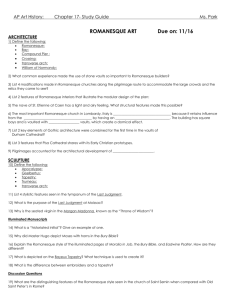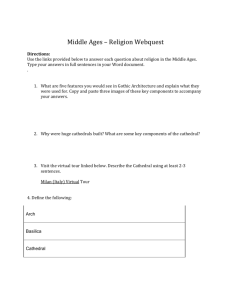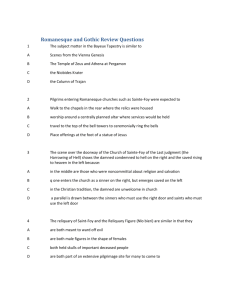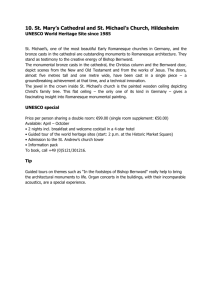document
advertisement
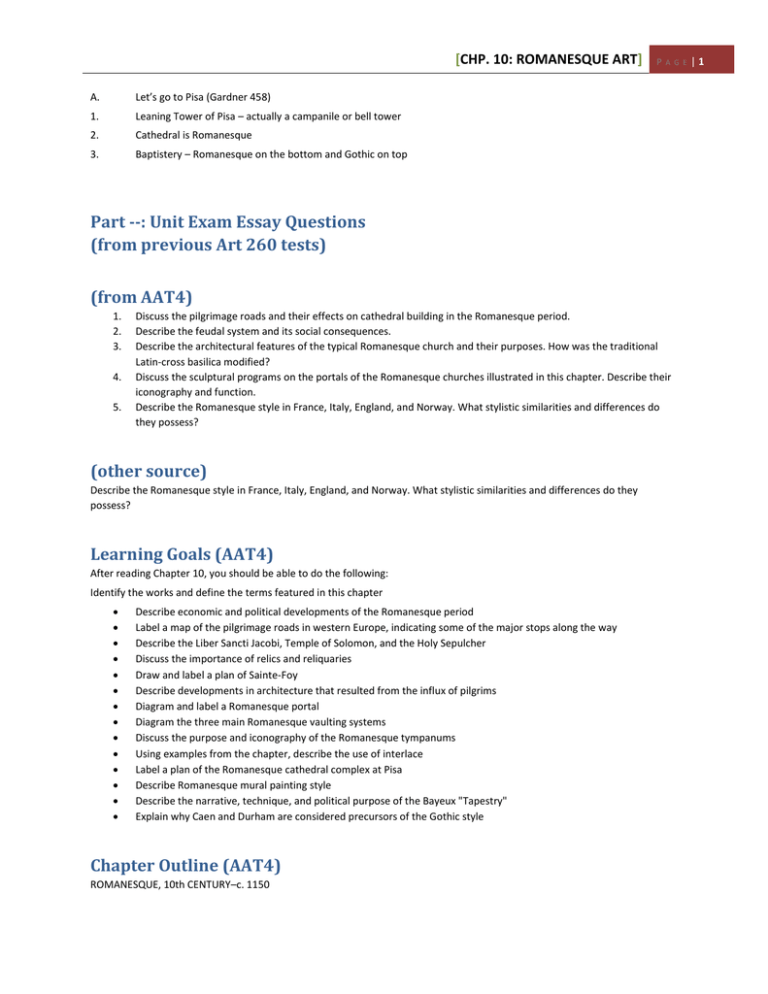
[CHP. 10: ROMANESQUE ART] A. Let’s go to Pisa (Gardner 458) 1. Leaning Tower of Pisa – actually a campanile or bell tower 2. Cathedral is Romanesque 3. Baptistery – Romanesque on the bottom and Gothic on top P A G E |1 Part --: Unit Exam Essay Questions (from previous Art 260 tests) (from AAT4) 1. 2. 3. 4. 5. Discuss the pilgrimage roads and their effects on cathedral building in the Romanesque period. Describe the feudal system and its social consequences. Describe the architectural features of the typical Romanesque church and their purposes. How was the traditional Latin-cross basilica modified? Discuss the sculptural programs on the portals of the Romanesque churches illustrated in this chapter. Describe their iconography and function. Describe the Romanesque style in France, Italy, England, and Norway. What stylistic similarities and differences do they possess? (other source) Describe the Romanesque style in France, Italy, England, and Norway. What stylistic similarities and differences do they possess? Learning Goals (AAT4) After reading Chapter 10, you should be able to do the following: Identify the works and define the terms featured in this chapter Describe economic and political developments of the Romanesque period Label a map of the pilgrimage roads in western Europe, indicating some of the major stops along the way Describe the Liber Sancti Jacobi, Temple of Solomon, and the Holy Sepulcher Discuss the importance of relics and reliquaries Draw and label a plan of Sainte-Foy Describe developments in architecture that resulted from the influx of pilgrims Diagram and label a Romanesque portal Diagram the three main Romanesque vaulting systems Discuss the purpose and iconography of the Romanesque tympanums Using examples from the chapter, describe the use of interlace Label a plan of the Romanesque cathedral complex at Pisa Describe Romanesque mural painting style Describe the narrative, technique, and political purpose of the Bayeux "Tapestry" Explain why Caen and Durham are considered precursors of the Gothic style Chapter Outline (AAT4) ROMANESQUE, 10th CENTURY–c. 1150 [CHP. 10: ROMANESQUE ART] Feudalism; pilgrimage roads; Crusades; relics and reliquaries; Song of Roland Sainte-Foy (Conques); Saint-Pierre (Moissac); Saint-Lazare (Autun); Pisa Rib vaults; barrel vaults; groin vaults Stavelot Triptych; manuscripts Stave church (Norway); stone interlace Bayeux "Tapestry"; Battle of Hastings (1066); Norman conquest of Britain Precursors of Gothic: Caen; Durham Summary and Study Guide Define or identify the following terms: AAT4 Key Terms abutment the part of a building intended to receive and counteract the thrust, or pressure, exerted by vaults and arches. archivolt the ornamental band or molding surrounding the tympanum of a Romanesque or Gothic church. bay a unit of space in a building, usually defined by piers, vaults, or other elements in a structural system. buttress an external architectural support that counteracts the lateral thrust of an arch or wall. campanile Italian for bell tower, usually freestanding, but built near a church. cluster pier, compound pier a pier composed of a group, or cluster, of engaged column shafts, often used in Gothic architecture. compound pier see cluster pier. crossing the area in a Christian church where the transepts intersect the nave. jamb the upright surfaces forming the sides of a doorway or window, often decorated with sculptures in Romanesque and Gothic churches. mandorla an oval or almond-shaped aureola, or radiance, surrounding the body of a holy person. portal the doorway of a church and the architectural composition surrounding it. program the arrangement of a series of images into a coherent whole. quadrant vaulting, halfbarrel vaulting vaulting whose arc is one-quarter of a circle, or 90 degrees. radiating chapels chapels placed around the ambulatory (and sometimes the transepts) of a medieval church. reliquary a casket or container for sacred relics. ribbed vault a vault constructed of arched diagonal ribs, with a web of lighter masonry in between. rosette circular stylization of a rose. stringcourse decorative horizontal bands on a building. transverse rib a rib in a vault that crosses the nave or aisle at right angles to the axis of the building. tribune (a) the apse of a basilica or basilican church; (b) a gallery in a Romanesque or Gothic church. trumeau(x) in Romanesque and Gothic architecture, the central post supporting the lintel in a double doorway. tympanum(a) a lunette over the doorway of a church, often decorated with sculpture. P A G E |2 [CHP. 10: ROMANESQUE ART] P A G E |3 UNIT 12 STUDY GUIDE Romanesque Art (AP Art History) Book Chapter 17—The Age of Pilgrimages: Romanesque Art, Pages 447-478 Helpful Text Boxes— A Pilgrim’s Gide to Santiago de Compostela, p. 450 Pilgrimages and the Cult of Relics, p. 449 The Romanesque Portal , p. 463 Assignment Read Chapter 17 and answer the following question in about a half page handwritten (legibly) in your notebook: 1. What significant changes occurred during the Romanesque? Of what importance were pilgrimages, the Crusades, and commercial trade in this period? What effect did the rise of towns have upon church architecture? 2. What significant developments occurred in architecture during this period? What are some reasons that these developments occurred? 3. What function did sculpture serve in this period? Where might sculpture be found in a church and for what purpose? Also, pick 10 terms from the “Terms” section that you do not known and define them in your notebook. Use your own words and images to define and describe the term. Many of these will benefit from being drawn! Terms be able to identify these by sight, explain these in relation to art, and know an example of each in relation to a work of art Christian Europe Twelfth-Century Awakening: heritage of Carolingian Renaissance end of Viking, Muslim, and Magyar attacks contact with Byzantine and Islamic civilizations Greek works they preserved more political order + stability more travel and connections and trade growth of cities Crusades feudalism and manorialism pilgrimages: (ideally to Jerusalem but...) Rome (St. Peter) Santiago de Compostela in Spain (St. James) pilgrimage routes relic [CHP. 10: ROMANESQUE ART] monasticism: Cluny Cistercians: St. Bernard of Clairvaux (1090-1153) Great Schism (1054) Latin cross crossing square module barrel vault tunnel vault hall church groin vaults alternate-support system campanile (bell tower) ribs (rib vaults) Normans Battle of Hastings (1066) buttresses baptistery incrustation pointed arch patron saint John the Baptist=patron saint of city of Florence the Last Judgment Gislebertus mandorla The Parts of a Cathedral: parts of a cathedral: Latin Cross ambulatory radiating chapels crossing transept bay pier nave aisles tower entrance apse P A G E |4 [CHP. 10: ROMANESQUE ART] P A G E |5 Arts Work know these works by sight, title, date, medium, scale, and location (original location also if moved) and be able to explain and analyze these in relation to any concept, term, element, or principle. (Bolded terms are most significant works from this period.) − Saint-Sernin, Toulouse, France, ca. 1070–1120. − Cluny III, b.1088, destroyed 18-19th centuries − Sant’Ambrogio, Milan, Italy, late 11th to early 12th century. − Saint-Étienne, Caen, France, begun 1067. − Durham Cathedral, England ,begun ca.1093. − Cathedral complex, Pisa, Italy; cathedral begun 1063; baptistery begun 1153; campanile begun 1174. − Baptistery of San Giovanni, Florence, Italy, dedicated 1059. − GISLEBERTUS, Last Judgment, west tympanum of Saint-Lazare, Autun, France, ca. 1120–1135. Marble, 21’ wide at base. [CHP. 10: ROMANESQUE ART] P A G E |6 − Pentecost and Mission of the Apostles, tympanum of the center portal of the narthex of La Madeleine, Vézelay, France, 1120– 1132. − RAINER OF HUY, baptism of Christ, baptismal font from Notre-Dame-des-Fonts, Liège, Belgium, 1118. Bronze, 2’ 1” high. SaintBarthélémy, Liège. − Funeral procession to Westminster Abbey (top) and Battle of Hastings (bottom), details of the Bayeux Tapestry, from Bayeux Cathedral, Bayeux, France, ca. 1070-1080. Embroidered wool on linen, 1’ 8” high (entire length of fabric 229’ 8”). Chronology Art Works know these works by sight, title, date, medium, scale, and location (original location also if moved) and be able to explain and analyze these in relation to any concept, term, element, or principle Summary and Study Guide Romanesque Study Guide - Page 1 Romanesque Study Guide: 1. What was meant by “The White robe of Churches”? 2. What was the goal of the pilgrimage road that went through Southwestern France & Northwest Spain. 3. Why was the use of stone vaults so important to Romanesque builders? 4. What advantage did stone vaults have over wooden roofs? 5. List 4 modifications made in Romanesque churches along the pilgrimage route to accommodate the large crowds and relics they came to see: 1. 2. 3. 4. 6. List 3 pilgrimage churches that had similar plans: _______________________ _______________________ _______________________ 7. List 2 features of Romanesque interiors that illustrate their modular plan’s design _______________________ _______________________ 8. How are the interior BAYS marked (indicated) on the exterior? 9. Compare Cluny III and Saint Sernin. Find 3 features that are the same, and 2 that are different: Same: _____________________ _______________________ _____________________ Different: _______________________ _______________________ 10. The main drawback of barrel vaulting was: 11. Label the Romanesque church plan with: Ambulatory, Apse, Bay, Buttress, Crossing, Nave, Transept, Radiating chapels, Aisles, choir [CHP. 10: ROMANESQUE ART] 12. What early Romanesque German church is known for being fully groin vaulted? 13. The above church’s nave’s interior shares what feature with the earlier Ottonian church of St. Michael’s at Hildesheim? 14. What is the name of the most important Romanesque church in Lombardy? 15. What early Christian feature does the above church utilize? 16. What creates the interior (of the above) vaulting’s domical effect? Romanesque Study Guide - Page 2 17. Explain how the proportions of height to width of Italian medieval churches compare to those of German churches: 18. What church was the master model of Norman Romanesque architecture? 19. List 4 progressive features of the building which look ahead to later Gothic style: 1. 2. 3. 4. 20. What is the name of a 6-part vault? 21. What 2 elements of Gothic architecture were combined for the first time in the vaults of Durham Cathedral? __________________________ ___________________________ 22. List 3 Early Christian features found in the Pisa Cathedral _________________________ __________________________ ________________________ 23. List 4 features in the Pisa Cathedral that are different than the Early Christian prototypes: 1. 2. 3. 4. 24. List 2 Tuscan Romanesque buildings in Florence: ____________________________________and ____________________________________ 25. What is the subject of the lintel of Saint-Genis-des-Fontaines? 26. Describe the style of the carving: 27. What inspired (was the prototype for) the stone carving of Christ in Majesty from St. Sernin? 28. What was the subject carved on the façade of Modena Cathedral? 29. What was the subject of the Tympanum at Moissac? 30. Name 3 Typical Romanesque sculptural stylistic conventions seen in the figures from Moisaac: 1. 2. Romanesque Study Guide - Page 3 3. 31. Label a Romanesque portal diagram with all the proper terms 32. What was the composition & subject of the Trumeau at Moisaac? 33. Where have we seen this subject before – what tradition did this follow? 34. What was the subject of the west tympanum of St Lazare at Autun? 35. Describe the composition & style: P A G E |7 [CHP. 10: ROMANESQUE ART] 36. What effect was it supposed to have on viewer and why/how? 37. Who is the work signed by? Why did the artist “sign” his work? 38. The Tympanum of the central portal at La Madeleine at Vezelay shows: 39. Describe the style of its figures: 40. How is the theme and iconography influenced by the Crusades? 41. List 3 characteristics that are unique in the portal sculpture of St. Trophime at Arles ( different from the styles of Vezelay and Autun) 1. 2. 3. 42. To what can these differences be attributed? 43. What Greco-Roman characteristic does Benedetto Antelami’s King David statue lack? 44. Describe the theme of Christ’s second coming as illustrated in the tympanum at Moissac (17-22) and in the Apocalypse of St Sever (17-35) Romanesque Study Guide - Page 4 45. What is the source of this imagery? 46. What is the subject of the page from Scivias in figure 17-36? 47. How is the subject communicated (what symbolism is used)? 48. What does this work tell us about the achievements of an outstanding medieval woman? 49. What is an historiated initial? 50. What is figure 17-37 a great example of? 51. How has the Romanesque style seen in the Bury Bible been modified from styles found in earlier works? 52. What is depicted on the Bayeux tapestry? 53. What technique was used to create it? 2 Discussion Questions: answer in thoroughly complete paragraphs, 1/2 page each. 1. What are the distinguishing features of the Romanesque style as seen in the Church of St. Sernin, as compared to Old Saint Peter’s in Rome (figure 11-70. Or • Describe the differing features of Northern European churches as they evolved from the Carolingian to the Romanesque style. Use specific example from the text. 2. Compare the carvings from St. Trophime at Arles (17-27) with the portal sculpture from Moissac (17-22) What is the subject of each portal? How do they differ stylistically? Explain any appearance of classical or earlier medieval stylistic features. *You can do the other #1 question for extra credit! P A G E |8

